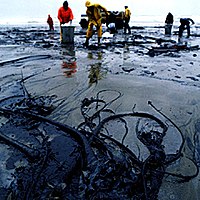
Photo from wikipedia
Dear Editor, Data on outcomes from severe poisoning in adults receiving extracorporeal membrane oxygenation (ECMO) is currently confined to single-center experiences or specific etiologies [1, 2]. While ECMO cannot facilitate… Click to show full abstract
Dear Editor, Data on outcomes from severe poisoning in adults receiving extracorporeal membrane oxygenation (ECMO) is currently confined to single-center experiences or specific etiologies [1, 2]. While ECMO cannot facilitate toxin removal, it may have a role in cardiopulmonary life support in patients with refractory respiratory failure or shock following poisoning [3]. We analyzed data from the Extracorporeal Life Support Organization registry based on ICD 9 criteria on adult patients with poisoning from 1999 to 2014 in order to study outcomes (Table 1). Analysis of the registry showed 41% mortality in this cohort of 83 patients, with a steady increase in reported ECMO use from 2011 to 2014 (ESM Fig. 1). More patients received ECMO for poisoning by medicinal substances and venovenous (VV)-ECMO was the predominant mode used. A total of 61.7% of the VVECMO patients received it for aspiration pneumonia or inhalational injury, with a survival rate of 89.3% in this subgroup. Univariate analysis assessed potential associations between survival and various pre-ECMO/ECMO factors including demographic information, ventilator and biochemical variables, ECMO mode, duration, and complications. Significant variables (p < 0.05) on univariate analysis (weight, ECMO mode/duration, neurological complications) were entered into a stepwise multiple regression model to identify predictors of mortality (ESM Tables 2, 3). Patients requiring ECMO were generally young but the ages of survivors and non-survivors were comparable (ESM Table 2). Multivariate analysis identified ECMO mode and the presence of neurological complications to be associated with mortality (ESM Table 6). Patients on VV-ECMO for poisoning had better survival. Nonsurvivors had a higher incidence of complications (ESM Fig. 2) and the presence of more than three complications was associated with higher mortality (ESM Table 4). Subgroup analysis of ECMO patients with severe poisoning before and after 2010 (ESM Table 5) revealed changes in patient population, indications for initiation, and management. After 2010, significantly more female patients were cannulated (72.7% vs 44.7%, p = 0.013) and patients received ECMO for poisoning more from medicinal than non-medicinal substances (72.9% vs 36.8%, p = 0.002). The ECMO initiation threshold was lower with early cannulation (median MV duration before ECMO 19.5 vs 63.5 h, p = 0.03) and a higher proportion of patients were cannulated with less severe hypoxemia (median ageadjusted oxygenation index 38.19 vs 50.79, p = 0.007). The SAVE and the RESP [4, 5] scores were comparable before and after 2010 implying that severity of illness did not differ (ESM Table 5B). The limitations of the study arise from its retrospective nature and lack of standardized criteria for ECMO use. The annual rise in ECMO patients could reflect changes in reporting. The heterogenous poisoning etiologies, lack
Journal Title: Intensive Care Medicine
Year Published: 2017
Link to full text (if available)
Share on Social Media: Sign Up to like & get
recommendations!